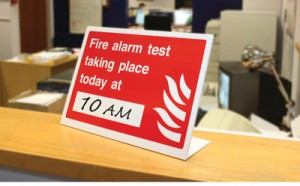Recently added item(s)
You have no items in your basket.

As recent events have all too tragically shown, having active fire prevention such as a fire alarm system, as well as passive protection measures like fire doors, is critical in helping to preserve life when a fire breaks out.
But what are the various types of fire alarm systems available and what is the difference between them?
Commercial fire alarm systems fall very broadly into two categories, conventional and addressable. In a conventional system, the various zones are wired from the alarm control panel on a radial circuit. The zone producing the fault or fire is indicated at the control panel but the individual detectors are not identified at the panel. An extension of the conventional system was introduced in the 1990’s with the introduction of two wire systems where, as the name suggests, two wires are used firstly as a detection circuit and then if the alarm is activated they carry the alarm signal.
With an addressable system - normally wired as a ring - each device is given a unique address so the detector or call point originating the alarm can be identified at the control panel and text on the panel indicates precisely the point causing the problem.
Addressable systems are termed as being either “open” or “closed” (although some manufacturers prefer the term “managed”). In an open protocol system, devices by such manufacturers as Apollo and Hochiki, are suitable for use on panels made by Kentec and C-Tec, to name just two. Closed or managed protocol systems, however, are where the devices and panels are made by one manufacturer, and the whole system is designed to work only with equipment from that manufacturer. A further, and more recent, development in the marketplace has been the emergence of wireless systems.
The importance of design and testing
The critical importance of designing the fire alarm system correctly at the point of installation cannot be underestimated. BS 5839-1: 2013 is the current code of practice that makes recommendations for the design, installation, commissioning and maintenance of fire detection and fire alarm systems in non-domestic premises.
A key part of BS5839-1 is the need to design the system to reduce or eliminate false alarms. These are not only costly to the Fire Services but there is also a cost to a business in terms of lost production and disruption caused by staff evacuation. According to the Fire Industry Association, it is estimated that false alarms cost UK businesses more than £1 billion per annum. You can read our previous blog posts about false alarms to learn more about how the design of your fire system can assist in reducing false alarm incidents and their associated costs.
Following installation ALL fire alarm equipment should be checked, including the smoke and heat detectors, the sounders, beacons and relays. Test and record everything and most importantly, it shouldn’t be assumed that because a device is connected, it will set off the alarm. It should be tested to prove it!
Maintenance and user training
When completing a fire alarm install, it’s all too easy for the engineer to test the last detector, check the panel is showing “normal” and then pack up his tools and leave, without first fully demonstrating the fire alarm to the end user – and while explaining the functions of the detectors and alarms, there is also an opportunity to cover the avoidance of false alarms.
It is also very important that all detectors are tested at least once a year. It’s amazing how much dust is created by an air conditioning outlet for example and the build-up of dust on a detector, caused perhaps by building work or air conditioning outlets is one of the five major causes of fire false alarms according to fire brigades. Here at Fire Depot we stock the Testifier range of testers to ensure that detector servicing is completed efficiently and safely.
Life is precious and property and assets matter. For help and advice on all fire protection and safety products, please contact the Fire Depot team on 0330 999 2233, email us at sales@firedepot.co.uk or visit www.firedepot.co.uk to see our full range of fire safety products.